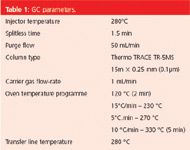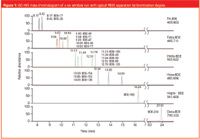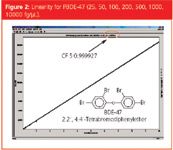Trace Analysis of Brominated Flame Retardants with High Resolution GC–MS
The Application Notebook
Polybrominated diphenyl ethers (PBDEs) are among the most important and widely used flame retardants. Recent legislation banned certain PBDE congeners.? EU directive 2003/11/EC prohibits the use of Penta-BDE and Octa-BDE for the member states of the European community.? Therefore, analysis of PBDEs have received increased interest as a result of their known toxicity.
Polybrominated diphenyl ethers (PBDEs) are among the most important and widely used flame retardants. Recent legislation banned certain PBDE congeners.1 EU directive 2003/11/EC prohibits the use of Penta-BDE and Octa-BDE for the member states of the European community.2 Therefore, analysis of PBDEs have received increased interest as a result of their known toxicity.
The most efficient trace analysis technique for BFRs proved to be high resolution GC–MS using an isotope dilution technique for quantification, especially suited for metabolism and accumulation studies in biological matrices.

Table 1: GC parameters.
Experimental Conditions
All measurements were performed on the DFS high resolution GC–MS coupled to a TRACE GC Ultra gas chromatograph with split/splitless injector. Samples were injected using the TriPlus autosampler.
GC column: Thermo TRACE TR-5MS, 15 m, 0.25 mm i.d., 0.1 μm film.
Injection volume: 1 μL of each sample.
GC temp. programme: see Table 1.
MS resolution: 10 000 (10% valley definition).
MID acquisition: one quantification and one ratio confirmation mass each, detailed MID set-up (see Table 1).
Internal standards: 13C labelled PBDE standards.
Analytical standards: Wellington Laboratories (not containing Octa- and Nona-BDEs).
Autotuning for the highest sensitivity was performed on PFK mass 480.9688.
PFK is also used as an internal mass reference providing a specific lock and calibration mass for each MID window (see Table 2). In every single MID measurement cycle, the instrument automatically performs an electric mass calibration taking these two reference masses as calibration points.

Table 2: MID set-up, MID lock mode (masses in brackets; optional second ratio mass for native PBDE).
Results
All congeners in the employed PBDE standard can be separated on the 15 m TRACE TR-5MS column (Figure 1) in the order of their bromination degree. The use of a short 15 m column with a thin film is recommended to analyse the thermolabile Deca-BDE.

Figure 1
The limits of quantification (LOQs) for the far higher boiling PBDEs are similar to those achieved for dioxin and PCBs. The quantification shows excellent linearity from the lowest fg range up to the highest standards (Figure 2).
Using the DFS high resolution GC–MS, polybrominated diphenyl ethers (PBDE) can be analysed with highest selectivity providing LOQs in the low femtogram range with the same analytical certainty as required in the analysis of dioxins and PCBs. For further information please visit www.thermo.com/dfs

Figure 2

Thermo Electron (Bremen) GmbH
Hanna-Kunath-Strasse 11, 28199 Bremen, Germany
tel. +49 421 5493-0
fax +49 421 5493-396
e-mail: hans-joachim.huebschmann@thermo.com
website: www.thermo.com
Reference
1. California Legislature Bill No. 302, Chaptered 11 August, 2003.
2. European Parliament and Council Directive 2002/95/EC on the Restriction of Hazardeous Substances (RoHS). European Parliament and Council Directive 2002/96/EC on Waist Electrical and Electronic Equipment (WEEE).
The Benefits of Custom Bonded Silica
April 1st 2025Not all chromatography resins are created equal. Off-the-shelf chromatography resins might not always meet the rigorous purification requirements of biopharmaceutical manufacturing. Custom bonded silica from Grace can address a wide range of separation challenges, leading to real performance improvements. Discover more about the latest innovations in chromatography silica from Grace, including VYDAC® and DAVISIL®.
5 Things to Consider When Selecting a Chromatography Silica
April 1st 2025Particularly in the pharmaceutical industry, drug purity isn’t just a goal – it’s essential for achieving safety, stability and efficacy. However, purification is easier said than done, especially with challenging molecules like DNA and RNA “oligonucleotides,” due in large part to their diversity and the range of impurities that can be generated during production. Enter DAVISIL® chromatographic silica, with a wide range of pore diameters and particle sizes to meet your specific application, performance and sustainability requirements. Before you choose the chromatography resin for your next purification application, take a look at these 5 considerations.
Automating Protein Purification: Efficiency, Yield, and Reproducibility
March 27th 2025Recent advancements in automated protein purification stress the importance of efficiency, scalability, and yield consistency. This eBook compares different purification platforms, highlighting their impact on downstream applications and demonstrating how automation enhances throughput and process control.
MilliporeSigma: Ultrapure Water for Sensitive LC-MS Analysis of Pesticides
March 25th 2025The aim of the study was to illustrate the efficiency of Milli-Q® water purification systems in eliminating pesticides from tap water, thereby producing and delivering reliable and consistent-quality ultrapure water suitable for pesticides analysis



